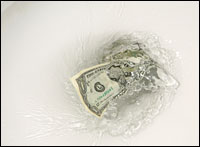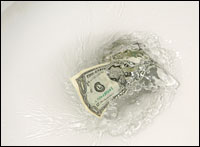Name this critical and declining natural resource: It is pumped through pipelines and delivered by trucks. It is essential to our daily lives and to every business process and function. Its uneven distribution around the globe leads to vast chasms in countries’ development and economies. Wars have been fought over it.

Water saved is a dollar earned.
Photo: iStockphoto.
If you’ve read the headline, you already know that the resource in question is not oil, but water. For companies, it’s a liquid asset that’s long been undervalued and overconsumed. The world’s freshwater supply is at risk, and the question is when and where, not whether, there will be major droughts or shortages that could dry up business and the bottom line.
As a result, some companies are tapping into water conservation, reuse, and recycling. A few are finding that doing more with less water represents a classic alignment of environmental and business goals. Water reduction, reuse, and recycling investments often have quick paybacks, especially when one considers the multiple business benefits water efficiency can provide.
Consider a few brief success stories:
- Graphic Sciences, a Portland, Ore., company that manufactures water-based inks, previously used about five gallons a minute in making pigments. The water, used only once, was dumped into the city wastewater system. After conducting a water audit, the company installed a cooling tower to recirculate the water. The tower cut water use by 80 percent — some 2.5 million gallons — as well as sewage costs. The $5,800 project costs were recouped in about two months.
- Gangi Brothers Packing Co., a tomato processing and canning plant in Santa Clara, Calif., monitored its water use to identify areas for savings. Before the audit, Gangi used some 148 billion gallons of water during a single canning season. After implementing conservation measures, water use dropped to 56.8 billion gallons. The combined capital and operating costs for water conservation were $89,500 per year, but the savings from lower sewer and water costs was $130,000 per year, yielding an eight-month payback.
- La Quinta Inns, based in Dallas, Texas, developed a utility management information system that allows analysis of utility expenses each month and flags deviations from normal use. The company works with facility managers and utilities to investigate high consumption and take corrective action. Often, the analysis identifies a problem before the facility manager is aware of it. In one year alone, such measures led to a 9.5 percent drop in per-guest water consumption, for a corporate-wide reduction of 76.5 million gallons.
- Gallo Wineries partnered with the Santa Rosa, Calif., Subregional Water Reclamation System to expand the city’s system to accommodate additional growth while providing a reliable supply of recycled water to Gallo during irrigation season. Gallo developed 350 acres of vineyards for irrigation and a 300 acre-foot reservoir, with the city providing the piping and pumping facilities. The finished system reuses 3.8 billion gallons of recycled water each year on more than 5,700 acres of mostly agricultural lands.
Awash With Benefits
The point of doing all these things is to shrink water bills, of course. But that’s only half the glass; saving water provides several other benefits for businesses. For example:
- Energy savings. The money saved on energy for heating, pumping, and treating water typically often outweighs the actual water savings.
- Reduced wastewater production. Less water going in means less wastewater going out, cutting firms’ sewer service costs. In some areas, wastewater utilities offer financial incentives for reduced wastewater output.
- Improved processes. Re-examining processes to minimize water and energy waste can suggest entirely new — and better — ways of accomplishing the same tasks.
- Higher productivity. Facilities that make better use of water and energy are typically more pleasant to occupy. Worker productivity and service quality may increase due to lower absenteeism and other factors.
- Ecosystem benefits. Using less water leaves more for local streams, wetlands, and their natural inhabitants. Regulatory requirements and incentives for doing so are increasingly common.
- Public relations value. Companies and other organizations perceived to be protecting the environment may enjoy a competitive advantage.
A lot of this is simple efficiency: tightening taps, installing more-efficient fixtures, checking for leaks, and the like. But new technologies are helping, too. For example, the city of San Diego designed a $150 million system to bring recycled water up to the quality of tap water and pump it back into the city’s reservoir.
While the high cost of such systems puts them out of reach for most companies, some lower-tech solutions are becoming increasingly affordable: constructed wetlands, biological filtration systems, and others.
Among the better-known is the Living Machine, created by biologist John Todd to treat high-strength industrial wastewater and sewage. Todd’s system harnesses sunlight and a diversity of organisms to digest organic pollutants. Todd’s satisfied customers include Ethel M. Chocolates in Henderson, Nev. The company’s Living Machine saves up to 20,000 gallons of water per day, with treated wastewater used for on-site irrigation. And the water-saver serves another duty: The Living Machine is included in Ethel M.’s factory tour, offering visitors and the company alike the sweet smell of success.
Drink It Up
GreenBiz offers a special resource center on water conservation. The U.S. EPA offers some good resources and tips on the topic. New York City’s NYCWasteLe$$ site offers useful hints for saving water at work. The nonprofit Global Environmental Management Initiative offers a Water Sustainability Tool with a wealth of suggestions and case studies.



